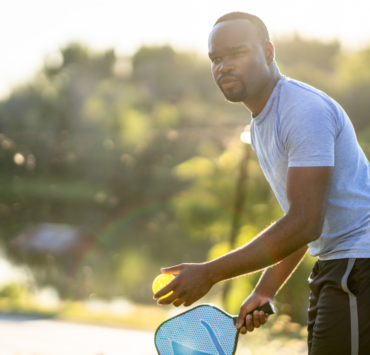Al Rodriguez is a 61-year-old PB Ambassador for Acacia Sports Pickleball Shoes. He and his wife, Rita Taylor-Rodriguez, are volunteer pickleball coaches. We sat down with them to learn about their teaching experiences and how they ended up volunteering to teach prisoners the love of pickleball.
What made you and your wife decide to explore the coaching world of pickleball?
We both fell in love with the sport so much that Rita wanted to start a mission to get as many folks introduced to it as possible. We are both certified coaches under the PPR Professional Pickleball Registry. So, we became volunteer certified coaches, and we prefer to work with beginners. We did a children’s clinic and realized how great we coach together. It has been such a blessing and relief from our high-stress careers in sales.
Can you share how you wound up teaching prisoners the game of pickleball?
Eric Genius at Concerts for Hope goes into prisons nationwide and performs concerts for the prisoners. He had arranged a concert at the Pac Unit in Navasota and invited Rita and me to attend. When we got into the recreation area where the concert was being held, I noticed three pickleball courts painted out on the floor. When I asked if they played pickleball there, the recreation director, Ruby H., stated how Warden Moises Villalobos was into pickleball and had lined out the courts, purchased paddles and balls, and comes in and hits balls with the prisoners. Some prisoners told us they did not know the game’s rules and would like to learn. So, we volunteered to come in and coach. Rita and I went in on a Tuesday morning, and we had thirty-six inmates lined up listening eagerly to our instruction, and we got them to a good playing level. Not long after, we were asked to do an in-prison tournament with thirty-six inmates.
How did this experience change your perspective (if at all) on the judicial system and incarceration as an institution for reform and second chances?
It was an eye-opening experience. At first, I was nervous. You walk into the prison with no phone, no ID, just a paddle and your clothes, with barred doors slammed behind you. Inside, you are genuinely in the prison population. That quickly subsided as we began to interact with the warden, the guards, and the prisoners. The judicial system has already tried them; we’re not there to do that. The ward gave us hand-made wooden commemorative Pickleball paddles that we will always cherish.
What type of students do you regularly teach?
We mostly prefer to teach beginners, whether children, teens, or adults. Introducing proper technique, etiquette, and rules is so gratifying for us. It is a lot of fun for Rita and me, especially when, after a nice training session, the teens will inevitably challenge us to a game and quickly learn that while we may be a few decades older, we have the skill to soundly give them a thrashing, and they laugh and challenge us again!
What are your current and future plans for teaching more prisoners and other giving-back plans?
The warden at the Pac Unit would like to start tournaments amongst other prisons, so he is reaching out to get that started. Rita still travels south Texas for work and carries her pickleball gear with her. She finds courts to play on in the evenings and volunteers her services to the beginners she meets on the courts.
What do you think it is about pickleball that connects us as a community?
It is a sport that anyone can play regardless of their fitness level, and men can play against women and not have the power up. It is a social sport that the community, like Rita and I, wants more people to learn. Everyone on the court is willing to help someone learn. If someone shows up to a court without a paddle, no problem; someone immediately volunteers their extra paddle, will show them how the paddles up system works, and make sure they get in the next foursome. It is great to see friends in their 80s out on the court and active, just like seeing the six-year-olds out there with their first paddle. It is truly the sport that brings people from opposite sides together, and you don’t care what each other’s affiliation is.



